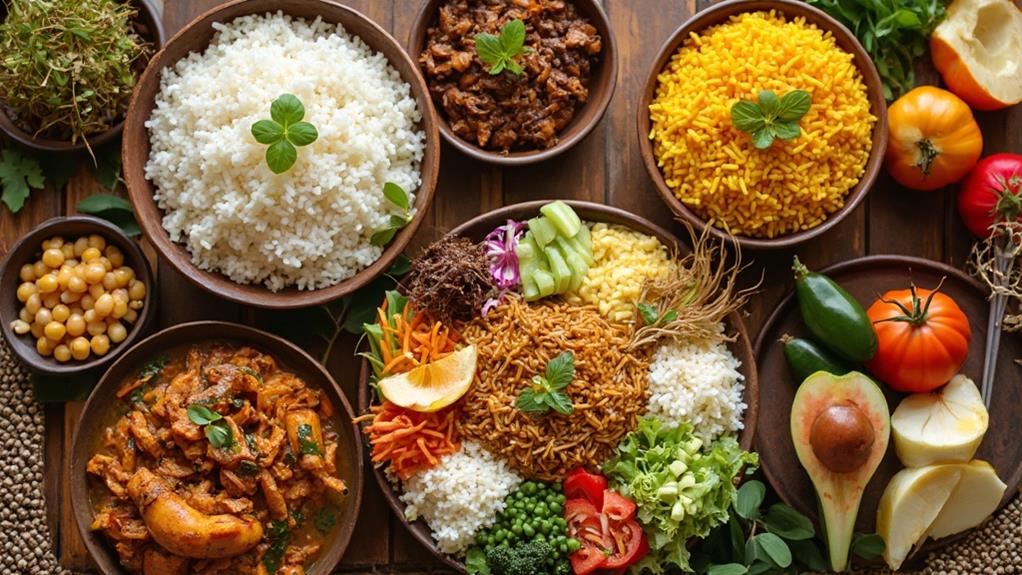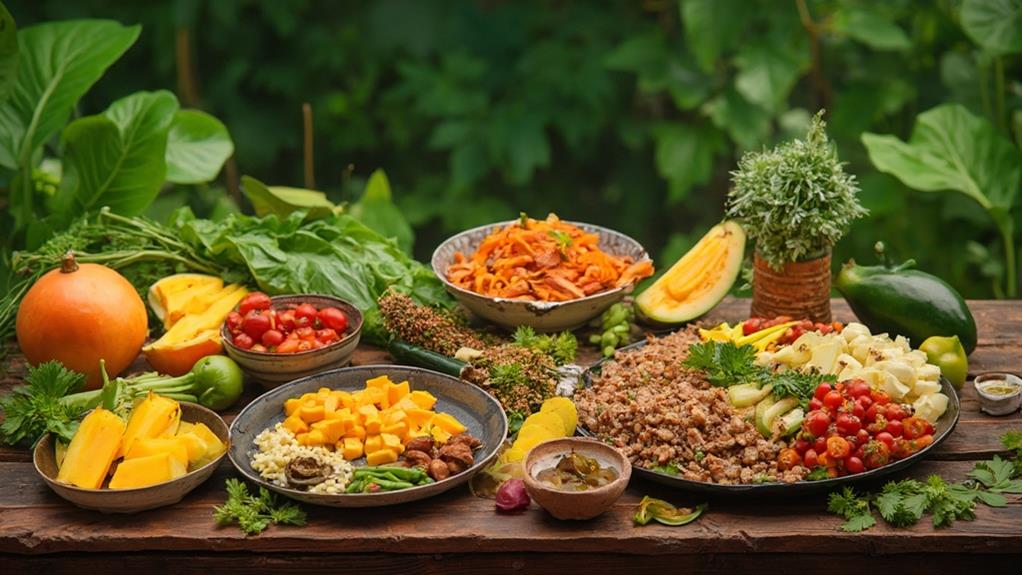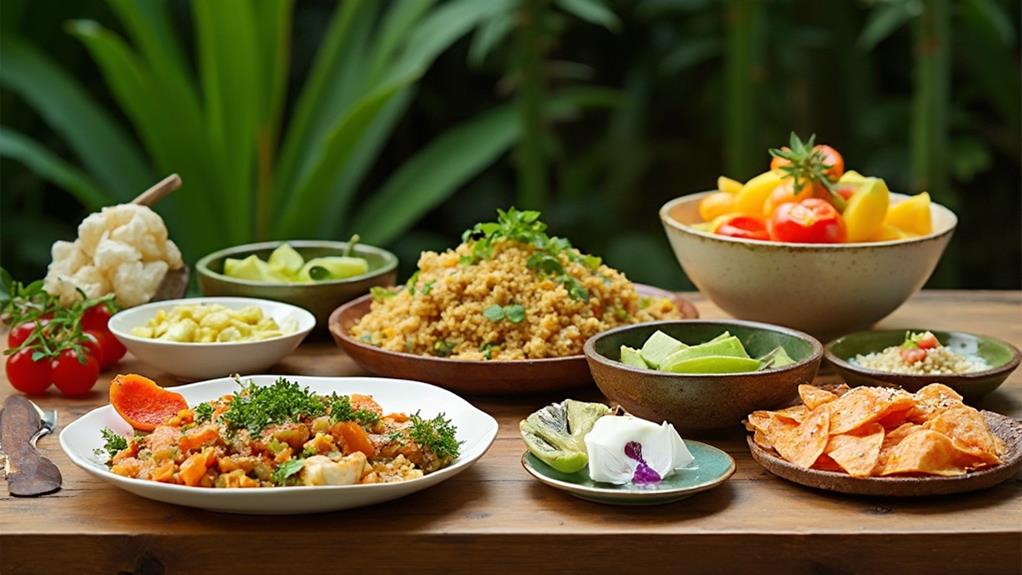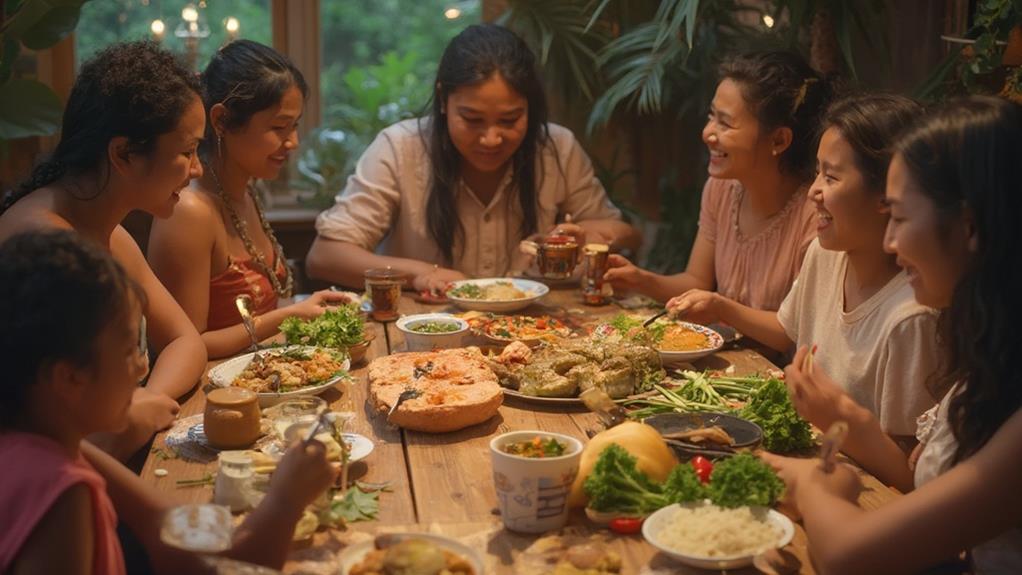A balanced diet is crucial in Filipino cuisine for maintaining overall health and well-being. This is achieved by combining essential macronutrients like carbohydrates, proteins, and healthy fats, which are reflected in the country's rich culinary heritage.
Rice, a staple in Filipino cuisine, provides energy. It is a primary source of carbohydrates, which are necessary for the body's energy needs.
Fish and lean meats are rich in protein, promoting muscle health. These protein-rich foods are essential for building and repairing muscles, making them a vital component of a balanced diet.
Incorporating fruits and vegetables into meals enhances nutrient intake. Vibrant fruits and vegetables are rich in vitamins, minerals, and antioxidants that are vital for overall wellness.
Traditional dishes can be adapted for nutritional balance. For example, adobo and sinigang can be prepared with healthier ingredients, ensuring that these flavorful dishes also provide the necessary nutrients for a balanced diet.
Harmonizing these elements leads to healthier meal options. By balancing macronutrients, protein, and nutrient-rich foods, individuals can create a vibrant culinary experience that nourishes both the body and the palate.
Historical Context of Filipino Cuisine
Filipino cuisine is a rich blend of cultural exchanges and influences.
Its roots can be traced back to indigenous traditions, which were shaped by trade and colonization. The early inhabitants of the Philippines used local ingredients like rice, fish, and tropical fruits to create dishes that reflected their environment.
For example, they made use of coconut milk, a staple ingredient in many Filipino dishes.
The arrival of the Spanish in the 16th century introduced new ingredients like tomatoes, garlic, and various spices. These elements blended with indigenous flavors to create iconic dishes like adobo, a stew made with meat or seafood, vinegar, soy sauce, garlic, and bay leaves, and sinigang, a sour soup made with tamarind broth and various vegetables.
The influence of Chinese traders is also evident in Filipino cuisine, with the introduction of noodles and soy sauce.
Pancit, a popular Filipino dish, is a stir-fry made with noodles, vegetables, and sometimes meat or seafood.
As you explore Filipino food, you'll notice regional variations that reflect local customs and available ingredients.
For instance, the Bicol region is known for its spicy dishes, while the Visayas region is famous for its seafood.
The influence of American colonization in the 20th century led to the incorporation of fast food and Western-style dishes.
This is evident in the popularity of dishes like burgers and fries in modern Filipino cuisine.
Understanding this historical context enriches your appreciation of Filipino cuisine and highlights the adaptability and resilience of its culinary traditions.
It shows how Filipino cuisine has been shaped by different cultures and influences, resulting in a unique and diverse culinary identity.
Key Components of a Balanced Diet
A balanced diet consists of macronutrients, essential vitamins, and minerals. Macronutrients include carbohydrates, proteins, and fats. Carbohydrates provide energy, proteins support muscle health and immune function, and fats are necessary for brain function and hormone production.
Incorporating a variety of food groups is crucial. Proteins can come from lean meats, fish, legumes, and tofu, which are prevalent in many Filipino dishes. These sources provide essential amino acids for muscle health and immune function.
Filipino staples like adobo and sinigang feature protein-rich ingredients like chicken, pork, and fish.
Fruits and vegetables are vital for vitamins and minerals. Filipino staples like malunggay (moringa) and kangkong (water spinach) offer significant nutrients while being low in calories. Aim to fill half your plate with these vibrant options.
Fruits like mangoes and bananas are rich in vitamins A and C, while vegetables like broccoli and pechay provide essential minerals like calcium and iron.
Healthy fats should come from sources like avocados, nuts, and coconut. While traditional Filipino dishes often feature fried items, opting for grilled or steamed alternatives can help you maintain healthy fat intake without excess calories.
Filipino dishes like grilled tilapia and steamed vegetables are great examples of healthy fat sources.
Hydration is key. Drinking plenty of water supports digestion and overall health. Aim to drink at least eight glasses of water a day to stay hydrated.
Role of Carbohydrates in Meals

Carbohydrates are a crucial source of energy for the body. In Filipino cuisine, various carbohydrate sources provide the necessary energy for daily activities. Staples like rice, bread, and root vegetables are essential for maintaining energy levels.
Complex carbohydrates, such as brown rice and sweet potatoes, are vital for stable energy levels. These carbohydrates digest more slowly compared to simple carbohydrates, helping to maintain stable energy levels throughout the day.
Fiber-rich carbohydrates, like vegetables and legumes, promote digestive health. Foods high in fiber help regulate the digestive system, preventing issues like constipation. Examples of fiber-rich carbohydrates include whole grain bread, brown rice, and legumes like lentils and chickpeas.
A balanced diet must include carbohydrates. Incorporating a variety of carbohydrate sources in meals ensures that the body is fueled effectively.
Importance of Protein Sources
Protein is a crucial component of a balanced diet, playing a vital role in building and repairing tissues, producing enzymes, and supporting immune function.
In Filipino cuisine, there are various protein sources to choose from, including meat, poultry, fish, eggs, and legumes.
Eating adequate protein helps with weight management as it can make you feel full longer. Incorporating protein-rich dishes like adobo or sinigang into your meals provides not only flavor but also essential amino acids.
Fish is an excellent protein source, offering omega-3 fatty acids beneficial for heart health. For example, tilapia or bangus are staple fish in Filipino cuisine that provide these benefits.
Legumes are a great plant-based protein option, making them perfect for vegetarian or budget-conscious meals. Mung beans (monggo) and lentils are excellent examples of legumes that can be easily incorporated into your diet.
Varying your protein sources ensures you meet your dietary needs and enjoy a diverse array of flavors and textures in your dishes.
Therefore, prioritize protein as a significant component of your balanced diet in Filipino cuisine.
Incorporating Vegetables and Fruits

Fruits and vegetables are essential for a balanced diet, offering a wealth of vitamins, minerals, and fiber.
Aim to fill half your plate with colorful fruits and vegetables during each meal to significantly improve your overall health. This not only enhances the visual appeal of your dishes but also ensures you're getting a variety of nutrients.
Incorporating fruits and vegetables into your meals is easy in Filipino cuisine.
Try adding leafy greens like kangkong (water spinach) or malunggay (moringa) to your soups and stews. You can also enjoy fresh salads with local ingredients like papaya, mango, or singkamas (jicama) as refreshing side dishes.
Munching on fruits like bananas or guavas can satisfy your sweet tooth while providing essential nutrients. When cooking, consider steaming or sautéing vegetables to preserve their nutrients.
Traditional Dishes and Nutritional Value
Traditional Filipino dishes can be a rich source of essential nutrients. Take adobo, a popular dish that combines meat with vinegar and spices, providing protein and essential vitamins while the vinegar contributes to digestion.
Filipino cuisine often features a variety of ingredients and cooking methods that promote a balanced diet. Sinigang, a staple dish, is loaded with vegetables like radish, eggplant, and leafy greens, making it a great source of vitamins A and C, as well as fiber. The sour tamarind base not only adds flavor but also offers antioxidants that can boost your immune system.
Peanut-based dishes can deliver healthy fats and protein. Kare-kare, a peanut-based stew that features oxtail and various vegetables, is a great example. The peanuts provide healthy fats and protein, while the vegetables enhance its nutritional profile.
Even dishes like lumpia can be nutritious when prepared mindfully. By opting for lean meats and incorporating more vegetables, you can turn these traditional favorites into balanced meals.
Filipino cuisine can indeed support a balanced diet when you pay attention to portion sizes and preparation methods.
How Can Filipinos Ensure a Balanced Diet While Catering to Food Allergies and Intolerances?
Filipinos can ensure a balanced diet while catering to food allergies in filipino cuisine by incorporating a variety of options. Using alternative ingredients like cassava, banana leaves, or coconut milk can help accommodate dietary restrictions. Additionally, educating oneself about common allergens and experimenting with different cooking techniques can help create delicious, allergy-friendly meals.
Modern Adaptations in Filipino Cooking

Modern Twists in Traditional Filipino Cooking
Healthier Ingredients: Chefs are replacing traditional ingredients with healthier alternatives. For example, brown rice is being used instead of white rice, and coconut oil is being used instead of lard.
This shift towards healthier ingredients is crucial for enhancing the flavor and texture of dishes like lechon.
Plant-Based Options: Filipino dishes are being reimagined with plant-based proteins. Adobo, a popular Filipino recipe, is now being made with plant-based proteins instead of meat, making it both delicious and nutritious.
Fusion Dishes: Filipino flavors are being combined with international flavors to create unique dishes. For instance, a Filipino-inspired quinoa salad or a sinigang with a twist, incorporating seasonal vegetables, can boost the nutritional profile of traditional Filipino dishes.
Meal Planning for Balanced Nutrition
Meal Planning for Balanced Nutrition in Filipino Cuisine
Assessing Nutritional Needs and Preferences
Meal planning is essential for achieving balanced nutrition, particularly in diverse cuisines like Filipino cooking. To start, assess your nutritional needs and preferences. Consider including staples like rice, vegetables, lean proteins, and healthy fats in your plan.
Creating Balanced Meals
To create balanced meals, aim for a plate that consists of half vegetables, a quarter lean protein, and a quarter whole grains. Filipino dishes like sinigang or adobo can be adapted to meet these guidelines. For example, add more leafy greens to sinigang or choose skinless chicken for adobo.
Effective Meal Planning Strategies
Make a grocery list based on your meal plan to avoid impulse purchases. Stick to seasonal produce to enhance flavor while keeping costs down.
Prep meals in advance to save time and resist unhealthy options during busy days. By following these strategies, you'll enjoy the rich flavors of Filipino cuisine while maintaining a balanced diet that supports your well-being.
Community and Family Eating Practices

Community and Family Eating Practices Foster Strong Relationships and Healthy Diets
In the Philippines, sharing meals is a vital tradition that strengthens family bonds and promotes health.
Eating together allows family members to share traditional recipes and cooking methods that emphasize fresh, local ingredients, promoting a deeper understanding of nutrition and a balanced diet. Regular family meals also provide a platform for open communication, essential for emotional well-being.
Traditional Folk Dances and Community Meals Encourage a Sense of Belonging
Similar to traditional folk dances like Tinikling and Singkil, community meals bring people together and foster a sense of community and belonging among participants.
These social rituals encourage the use of diverse ingredients, contributing to a well-rounded diet.
Cultural Heritage and Community Meals
Community meals celebrate Filipino heritage, reinforcing cultural identity and values.
They provide an opportunity to pass down traditional recipes and cooking methods, preserving cultural heritage. By sharing meals, families can bond over their cultural roots and promote a deeper appreciation for their heritage.
